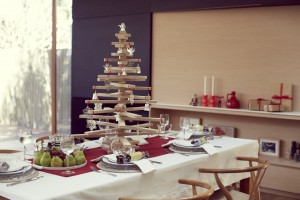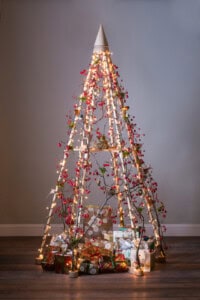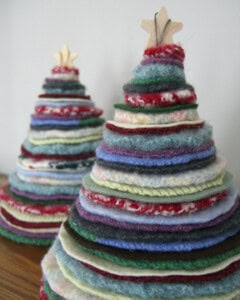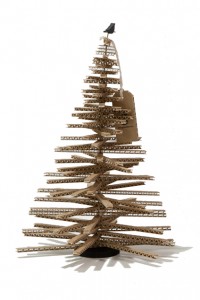With growing environmental concerns over using real trees and with the most common alternative being plastic, designers are rising to the challenge by creating affordable and sustainable Christmas trees that don’t scrimp on style
Real or plastic? This is the Christmas conundrum that has plagued environmentally conscious consumers for years now.
On one hand, real Christmas trees can be naturally grown with the added bonus of absorbing carbon dioxide as they do so. Plus they can be locally sourced, which reduces transport emissions.
However, real Christmas trees are usually grown on plantations – often in areas where natural woodland once stood – with chemical pesticides and fertilisers commonly used to produce them. Many of these trees then go to waste after the festive season. According to the Guardian, just 10% of the six million real trees that are bought each Christmas across the UK are recycled for compost and woodchip, with the rest ending up in landfill. So a real tree is not the obvious eco-option it first seems.
On the other hand, while a fake tree can be re-used year after year, The Ecologist magazine says that the majority are imported from China and are made of non-biodegradable plastics. These plastics are made from increasingly scarce oil resources, which are also damaging to extract. And even though fake trees may last longer than real trees for many households, they are still likely to end up in landfill where their plastics contaminate the land.
Now designers across the globe are rising to the challenge posed by this dilemma by creating stylish, reusable trees that won’t cost the Earth – environmentally or financially. A wide variety of materials, from locally sourced wood to recycled clothing, are going into the designs, presenting a stimulating challenge to create a sustainable equivalent for such a classic object.
“With most probably being thrown away after three or four weeks, we think that the Christmas tree is worth rethinking,” says Sarah Monkton from US company Jubiltree, which makes alternative wooden Christmas trees. “Our tree marries the best of the real tree and the artificial tree. It’s natural, like a real tree, but it is also reusable like an artificial tree. We hope our trees will help start a conversation about this issue and show there is another way to enjoy this special tradition.”
Our favourite alternative trees:
One Two Tree
Made by Australian couple Lucy and Ant McNamara after they struggled to find an eco-friendly tree for their first family Christmas, this self-assemble tree is made from sustainably grown local plywood and is designed to be a natural, durable alternative to a real tree.
More information: www.onetwotree.com.au
Treeasy
Designed by Argentinean designer José Manuel Rebert Alarcon, this flat-pack aluminium tree is both reusable and multi-functional. When not fully expanded as a tree, it can be used flat as a tray or under-plate, and can also be half-expanded for use as a fruit or bread basket.
More information: www.galeria.innovar.gob.ar/12303
Jubiltree
This wooden frame tree from Maine, USA is designed to be used creatively. Its simple structure means that households can decorate it however they wish and can vary its look every year.
More information: www.jubiltree.com
Thrifted Holiday Tree
This crafty DIY idea by Ellen Luckett Baker uses recycled woollen jumpers to create colourful-looking trees. Instructions are available online to allow anyone to make their own.
More information: www.thelongthread.com
Giles Miller Christmas Tree
Created by London-based interior and surface designer Giles Miller, this tree is made mainly from cardboard, making it both reusable and recyclable. It can also be arranged in a variety of forms to create several different-looking trees.
More information: www.gilesmiller.com and www.designmuseumshop.com





